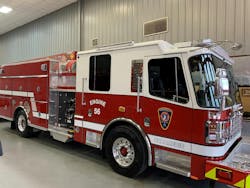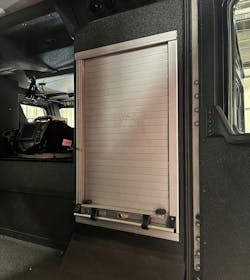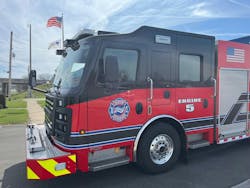Note: This article is part of the Firehouse 2024 Apparatus Supplement. To read the entire supplement, click here.
Fire department apparatus committee members and fire apparatus manufacturers alike have made great strides over recent years in taking full advantage of the space that’s within the cab of custom fire apparatus. Whether an organization practices a Clean Cab concept or a “Cleaner Cab concept,” there’s significant space for both fire and EMS equipment that can enhance the operational effectiveness of the fire company greatly. Furthermore, interior cab specification items that the apparatus committee can identify can allow for the future addition of equipment that requires proper mounting and/or charging ports.
EMS compartments
Storage compartments for EMS equipment are, perhaps, the most common in-cab compartments that are added to fire apparatus. This simply is because most staffed fire apparatus respond to more EMS incidents than to fire incidents.
Mounting options for these compartments are on the standard rear-facing seat riser or the forward-facing rear seat riser.
The apparatus committee must determine which layout, or combination thereof, best will fit the equipment that the department plans to carry. This includes compartment dimensions, shelving requirements, 12- and 120-volt power, and door type. Another question to ask: Is exterior access required for the compartment via the sidewall of the apparatus.
Most apparatus are staffed with cross-trained firefighter/paramedics. This allows for the most efficient EMS deployment model because of the strategic location of fire stations within communities. With this level of prehospital care comes an extraordinary amount of essential equipment that must not only be carried but secured. The apparatus committee must take great care to ensure that the compartment dimensions can accommodate all of the equipment that’s required. Door options include netting, roll-up doors, Lexan, aluminum plate and simple straps. Security of ALS medications as well as temperature regulation must be taken into account.
Exterior door access into the EMS compartment on the rear-facing seat riser is an extremely popular option these days. It’s more commonly located on the officer’s side of the unit.
Compartments that are in the cab extension that transverses under the forward-facing rear seat riser also are commonplace. These compartments either can include roll-up or traditional pan doors. Either way, these doors should be lockable if a medications bag is stored within the compartment. If the apparatus is equipped with electronic door locks, doors can be programmed into the system.
Overhead compartments
Overhead storage compartments can be built into the raised roof of apparatus and can be forward- and rear-facing. These compartments are more common on heavy rescue and squad companies, but they can play a vital role in basic engine companies as well to increase valuable storage space.
Specification of overhead compartments by the apparatus committee is similar to specification of EMS compartments. However, often, the equipment that’s stored in these areas is different.
We regularly see storage of ice and swift-water rescue gear in these compartments for rapid deployment at time-sensitive incidents. Meter banks for hazmat incidents usually are kept in these locations, too.
Again, electrical requirements for, in this case, charging meter banks must be taken into consideration by the apparatus committee.
Shelving and horizontal dividers also are options.
Lastly, the door options for these compartments include horizontally hinged Lexan, netting, aluminum plate and sliding Lexan doors.
Overhead storage compartments and EMS compartments are considered “bolt-on” options. With the price of purchasing new fire apparatus today, these items might need to be added later as additional funding becomes available. (Departments also might wish to add these compartments to older apparatus or to apparatus for which the mission of the unit changed. Most of these items can be fabricated locally and easily installed for a nominal cost.)
Tools
Interior tool mounting is another area of concern for the apparatus committee. Often, equipment that’s specific to a company’s seat-riding assignment is mounted. This includes hooks, irons, water cans, box lights, TICs and search ropes.
Tool mounting locations include the back of the engine house, the side of EMS compartments, doors, doorsteps and rear cab walls and in the cab extension on the exterior. Any equipment that’s in the cab must be mounted with approved hardware and brackets that meet rollover requirements.
Mounting plates for engine houses are another good way to ensure that equipment is secured properly. Often, these plates are constructed out of ¼-inch aluminum plate.
Other mounting systems, such as tool boards and peg boards, also are good ways to secure equipment and to allow for future addition of equipment on vertical surfaces.
When aluminum plate is used in the engine house, it’s recommended that it be mounted on a ½-inch riser, so the bottom side can be used as a wire chase. The aluminum plate is a premium location to mount map boxes, TICs, light boxes and portable batteries. Another advantage of the mounting plate: When the layout is changed over the life of a vehicle, drilling directly into the engine house isn’t necessary. This can prevent costly errors down the road.
Power
In-cab electricity (12- or 120-volt) should be provided for the current and future needs of the apparatus that’s being designed. Members of the apparatus committee should specify whether outlets are “battery hot” or “ignition hot” and the location of each.
Also, if shoreline power is required, it must be identified by the committee in the written specification.
Cigarette lighter plugs and USB outlets are common locations for 12-volt outlets to be installed.
All of these outlets should be marine grade.
MDTs and radios
Mobile data terminals (MDT) and mobile radios are another area of concern for the apparatus committee in addressing apparatus cab design. It’s important that the MDT and mobile radio(s) be mounted so as not to obstruct the operator’s view of the officer’s side mirror.
Putting the MDT on a slide-out tray can help to bring the unit off of the dash and closer to the officer.
Other items that can be mounted in these locations include mobile radios, arrow stick controllers, Knox Box systems, preemption systems, headset controllers and AM/FM stereos.
Power requirements also must be carefully considered for these units as well as any accessories, such as GPS. Each requires its own 12-volt power supply. Note: Cowl-mounting the officer’s side mirror also can help with the operator’s view of the mirror.
Electrical components
I’m a proponent of allocating for future growth in apparatus design. This not only includes space but electrical components, too. With the multiplexed generation of fire apparatus, you don’t want personnel getting into the chassis wiring system if at all possible. Specifying 12-volt marine-grade power panels at various locations on the apparatus can keep this from happening. This allows for future additions without getting into the main wiring of the apparatus down the road. Additional radio power studs in the dash are another good idea and allow for future electrical growth for radio components. We often specify one being “ignition hot” and the other “battery hot” for versatility.
Vehicle lifetime
Spending time at the initial stages of the specification process by the apparatus committee can allow a significant amount of customization to the interior cab at a relatively low cost. This is the case for storage of valuable fire and EMS equipment that can be safely stored or mounted. Additionally, smart dash layouts and electrical components allow for better operator visibility and modifications over the life of the unit without getting into the onboard chassis wiring.
About the Author

Mark Miller
Mark Miller is a 26-year veteran of the fire service and currently is a deputy fire chief in Southwest Ohio. He holds a master’s degree in public safety administration, the Executive Fire Officer designation from the National Fire Academy and the Chief Fire Officer designation through the Center for Public Safety Excellence. Miller routinely speaks on fire apparatus positioning on the fireground and conducting an apparatus needs analysis.


